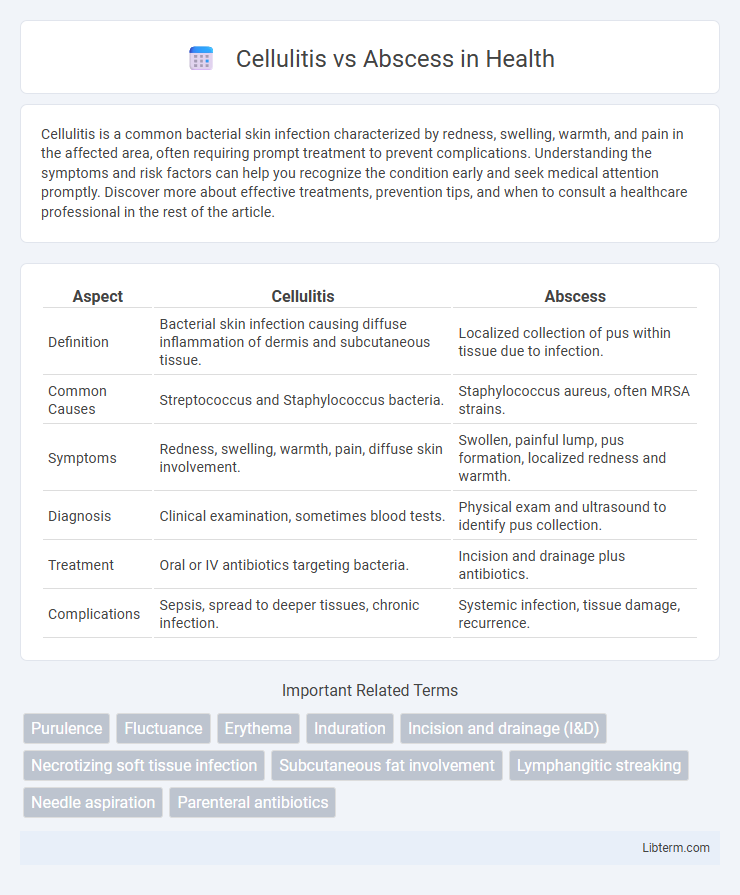Cellulitis is a common bacterial skin infection characterized by redness, swelling, warmth, and pain in the affected area, often requiring prompt treatment to prevent complications. Understanding the symptoms and risk factors can help you recognize the condition early and seek medical attention promptly. Discover more about effective treatments, prevention tips, and when to consult a healthcare professional in the rest of the article.
Table of Comparison
| Aspect | Cellulitis | Abscess |
|---|---|---|
| Definition | Bacterial skin infection causing diffuse inflammation of dermis and subcutaneous tissue. | Localized collection of pus within tissue due to infection. |
| Common Causes | Streptococcus and Staphylococcus bacteria. | Staphylococcus aureus, often MRSA strains. |
| Symptoms | Redness, swelling, warmth, pain, diffuse skin involvement. | Swollen, painful lump, pus formation, localized redness and warmth. |
| Diagnosis | Clinical examination, sometimes blood tests. | Physical exam and ultrasound to identify pus collection. |
| Treatment | Oral or IV antibiotics targeting bacteria. | Incision and drainage plus antibiotics. |
| Complications | Sepsis, spread to deeper tissues, chronic infection. | Systemic infection, tissue damage, recurrence. |
Understanding Cellulitis: Definition and Causes
Cellulitis is a bacterial skin infection characterized by redness, swelling, warmth, and pain, primarily caused by Streptococcus or Staphylococcus bacteria entering through breaks in the skin. Unlike abscesses, which are localized collections of pus, cellulitis affects the deeper layers of the skin and subcutaneous tissues, spreading diffusely. Common causes include cuts, insect bites, surgical wounds, or compromised skin barriers, which facilitate bacterial invasion and inflammation.
What is an Abscess? Key Features and Origins
An abscess is a localized collection of pus caused by a bacterial infection, typically developing when the body's immune system isolates the infection to prevent its spread. Key features include swelling, redness, warmth, pain, and often a visible or palpable lump filled with pus. Abscesses commonly originate from bacterial invasion through skin breaks, hair follicles, or deeper tissue infections, requiring drainage and antibiotic treatment for resolution.
Comparing Symptoms: Cellulitis vs Abscess
Cellulitis typically presents with diffuse redness, swelling, warmth, and tenderness of the affected skin, often accompanied by fever and chills. Abscesses are characterized by a localized, painful, swollen lump filled with pus, with a fluctuant center that may spontaneously drain. While cellulitis involves spreading inflammation of the skin and subcutaneous tissue, abscesses form a confined pocket of infection requiring drainage.
Physical Examination Differences
Cellulitis presents as diffuse skin redness, warmth, and swelling without a defined fluctuance, indicating a spreading bacterial infection in the dermis and subcutaneous tissues. An abscess is characterized by a localized, tender, fluctuant mass with a palpable pus-filled cavity, often accompanied by surrounding induration and erythema. Physical examination of cellulitis typically reveals diffuse tenderness and ill-defined margins, whereas an abscess shows a well-demarcated, raised area with central softening due to pus accumulation.
Diagnostic Methods for Accurate Differentiation
Ultrasound imaging is a critical diagnostic method for distinguishing cellulitis from an abscess, as it reveals fluid collections typical of abscesses absent in cellulitis. Laboratory tests including complete blood count (CBC) and inflammatory markers such as C-reactive protein (CRP) help assess the severity of infection but cannot definitively differentiate between the two. Clinical examination combined with imaging and laboratory findings ensures accurate diagnosis, guiding appropriate treatment strategies for cellulitis or abscess.
Common Risk Factors and Predisposing Conditions
Cellulitis and abscess share common risk factors such as skin trauma, insect bites, and underlying conditions like diabetes mellitus that impair immune response. Both infections are more prevalent in individuals with obesity, peripheral vascular disease, or a history of recurrent skin infections. Compromised skin integrity from dermatitis or fungal infections also predisposes patients to these bacterial skin infections.
Treatment Approaches: Antibiotics vs Drainage
Cellulitis typically requires systemic antibiotic therapy targeting common causative bacteria such as Streptococcus and Staphylococcus species, emphasizing early intervention to prevent spread. In contrast, abscess treatment prioritizes incision and drainage to remove purulent material, with antibiotics reserved for cases with surrounding cellulitis or immunocompromised patients. Accurate differentiation between cellulitis and abscess through clinical evaluation and imaging guides the appropriate use of antibiotics versus surgical drainage for effective resolution.
Potential Complications and Outcomes
Cellulitis can lead to serious complications such as sepsis, lymphangitis, and chronic swelling if untreated, while abscesses may result in tissue necrosis, systemic infection, and prolonged recovery. Both conditions carry risks of spreading infection to deeper tissues or the bloodstream, necessitating prompt diagnosis and intervention. Effective management reduces the likelihood of complications like bacteremia, septic shock, and permanent tissue damage.
Prevention Strategies for Both Conditions
Effective prevention strategies for cellulitis and abscess center on maintaining proper skin hygiene and promptly treating any cuts or wounds with antiseptics to prevent bacterial entry, especially targeting Staphylococcus aureus and Streptococcus pyogenes. Regular moisturizing to avoid skin cracks, wearing protective clothing in high-risk environments, and managing chronic conditions like diabetes significantly reduce infection risks. Vaccination against relevant pathogens and early medical intervention for skin infections further lower the incidence of both cellulitis and abscess formation.
When to Seek Medical Attention
Seek medical attention immediately if symptoms of cellulitis include rapidly spreading redness, swelling, intense pain, fever above 101degF, or red streaks extending from the affected area, signaling potential systemic infection. An abscess requires prompt evaluation if there is a painful, swollen lump filled with pus, increasing size, fever, or if it fails to improve within a few days of home care. Early intervention by healthcare professionals is critical to prevent complications such as sepsis or tissue necrosis.
Cellulitis Infographic

 libterm.com
libterm.com